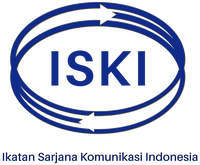Aktivitas Hubungan Masyarakat Universitas Negeri Berdasarkan Teori
Abstract
Keywords
Full Text:
PDFReferences
Akanwa, P. C., Anyanwu, E. U, Ossai-Onah, O. V. (2013). Population control in Nigeria: Implications for librarians. Retrieved from https://www.questia.com/read/1P3-3879700741/population-control-in-nigeria-implications-for-librarians
Bowen, S. A., Rawlins, B., & Martin, T. (2010). Best practice for excellence in public relations from overview of the public relations function. Harvard: Harvard Business Publishing.
Cameron, G.T., Cropp, F., & Reber, B.H. (2001). Getting Past Platitudes: Factors Limiting Accomodation in
Public Relations. Journal of Communication Management, 5 (3), 242-261.
Cutlip, S., Center, A., & Broom, G. (2011). Effective Public Relations. Jakarta: Kencana Prenada Media Group.
Dikopoulo. A., & Athanassions Mihiosis. 2013. The Contribution of records management to good governance. TQM Journal, 24(2), 123-141.
Edes. B.W. (2000). The role of public administration in providing information information offices & citizens information services. Presentation at the EIPA Seminar on “An Efficient, Transparent Government and the Rights of Citizens to Information”. Netherlands
Fairbank, J., Plowman, K. D., & Rawlins, B. L. (2007). Transparency and city government communication. Journal of Public Affair, 7, 23-27.
Fawkes, J. (2004). What is Public Relations. In A. Theaker (Ed.), The Public Relations Handbook. New York: Routledge.
Gower, K. K. (2006). Public Relations Research at The Crossroads. Journal of Public Relations Research, 18(2), 177-190.
Grunig, L. A., Grunig, J. E., & Dozier, D. M. (Eds.). (2008). Excellence public relations and effective organization. New Jersey: Lawrence Erlbaum.
Grunig, J. E., & Hunt, T. (1984). Managing Public Relations. New York: Rinehart & Winston.
Harrison, K. (2009). Strategic Public Relations: A Practical Guide to Success. Perth: Century.
Kent, M. L., & Taylor, M. (2007). Beyond Excellence: Extending The Generic Approach to International Public Relations The Case of Bosnia. Public Relations Review, 33, 10-20.
Kriyantono, R., Destrity, N. A., Amrullah, A., & Rakhmawati, F. (2017). Management of public relations for supporting the anti-corruption national program in Indonesia. International Journal of Applied Business and Economic Research, 15(20), 293-303.
Kriyantono, R. (2017). Teori public relations perspektif barat dan local: Aplikasi penelitian dan praktis. Jakarta: Prenada.
Kriyantono, R. (2015). Public relations, issue, & crisis management. Jakarta: Prenada.
Lattimore, D., Baskin, O., Heiman, S., & Toth, E. L. (2013). Public Relations: The Profession and The Practice. New York: McGraw-Hill.
Mendel, T. (2012). Freedom of information as an internationally protected human right. Retrieved from http://ww.article19.0rg/pdfs/publications/fori-as-an-international-right.pdf, in 2 October 2015
Motion, J. & Leitch, S. (2000). The truth games of public relations politics. Australian Journal of Communications, 27(2), 65-80.
Ohemeng, F. L. K., & Adarkwa, K. (2014). Overcoming the digital divide in developing countries: An examination of Ghana’s strategies to promote universal access to information communication technologies (ICTs), Journal of Developing Societies, 30(3), 297-322.
Oswald.J. (2009). Transparency and city government communications. All Theses and Dissertations. Brigham Young University.
Parthawa, P.B., Kriyantono, R., & Wisadirana. (2015). A Test of Five-Factor Model on Different Roles of Government and Private Public Relations Practitioners in Indonesia. Global Journal of Human-Social Science, 15(4), 17-22.
Pasadeos, Y., Berger, B., & Renfro, R. B. (2010). Public Relations as a Maturing Discipline: An Update on Research Networks. Journal of Public Relations Research, 22(2), 136-158.
Prabowo, R.D. (2014). Implementasi undang-undang keterbukaan informasi publik dalam upaya mewujudkan good governance (kajian tiga badan publik: Bappeda, Dpkad Dan Dinas Pendidikan Kota Semarang). Universitas Diponegoro.
Pradipta, H. (2013). Keterbukaan informasi publik Di Jawa Timur (Studi kasus sengketa informasi publik). Universitas Brawijaya : Malang.
Purdy, A. C., Idriss, A., Ahern, S., Lin, E., Elfenbein, D. M. (2017). The readability and accuracy of patient education websites for Graves’ disease treatment. Surgery, 162(5), 1148- 1154.
Rayudaswati. (2015). Public information management service in south sulawesi. Journal of Public Administration, 13(14),1-12.
Retnowati, E. (2012). Keterbukaan informasi publik dan good governance (antara das sein dan das sollen). Jurnal Perspektif, 27 (1), 55-60.
Schenkeelar, F., & Ahmad, I. (2004). Transparency and accountability in the public sector in the arab region. Paper for access to information, transparency and accountability, 1(6), 1-16.
Searson, E. M., & Johnson, M. A. (2010). Transparency laws and interactive public relations: An analysis of latin american government websites. Public Relation Review, 36, 120-126.
Suharyanti,. Widiastuti., Kania. (2012).Reformasi birokrasi pemerintah dan penerapan excellence theory. Jurnal Ilmu Komunikasi, 10(1), 53-63.
Syahri, M. A., Kriyantono, R. & Nasution, Z. (2015). An Explanative Study on The Different Perceptions of Journalists Toward Media Relations of Governmental and Private Public. Asian Journal of Humanities & Social Sciences, 3(1), 36-48.
Vercic, D., Vercic, A. T., & Sriramesh K. (2015). Looking for digital in public relations. Journal of Public Relations Review, 41, 142-152.
Wakefield, R.I., & Walton, S, I. (2010). The translucency corollary: Why full transparency is not always the most ethical approach. Public Relations Journal, 4 (4), 10-23.
Wijayanti, S. (2018). 10 Ciri Dasar Generasi Millennial, Kamu Termasuk Gak Nih? Retrieve from https://www.idntimes.com/life/inspiration/sinta-wijayanti- d/10-ciri-dasar-generasi-millennial-c1c2/full.
DOI: https://doi.org/10.36080/ag.v7i2.901
Refbacks
- There are currently no refbacks.
Copyright (c) 2019 Avant Garde

This work is licensed under a
Creative Commons Attribution-ShareAlike 4.0 International License. Visit to our university official website: www.budiluhur.ac.id





